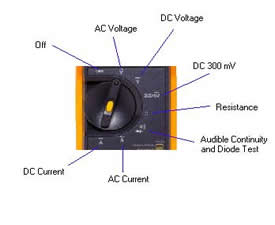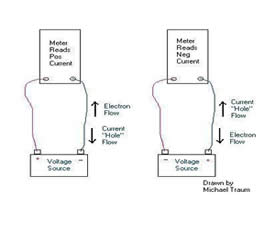How to Read Omens O N Fluke Multimeter
Fluke Type 73 Digital MultiMeter
Introduction
A multi meter is modest portable device that can be used to mensurate voltage, current resistance, or to exam diodes. The Engineering department at Humboldt has a set of Blazon 73 -3 Series 3 hand held digital multi meter manufactured by Fluke. These meters are over voltage protected against transient voltage spikes and
accommodate to International Electrotechnical Commission's safety standard IEC 61010. The meters feature an automatic concur to store a reading, and an audible continuity beeper, and can test diodes. A portable paw held multi meter can be used anywhere that quick accurate readings of voltage, current, or resistance are required. The specific applications of this device are numerous.

Effigy i: The Fluke Type 73 MultiMeter
The meter could be used for all of the following, and much more.
- Checking the output of a solar cell
- Measuring the current draw of small Ac or DC equipment
- Verifying power supply to a slice of equipment which is not functioning
- Testing an incandescent lite bulb
- Reading the voltage signal from pyranometer
- Diagnosing the ignition system on your motorcar when it does not start after you lot take spent the day in the field in a remote location.
When using a multi meter and interpreting the results gained it is often useful to have a working understanding of Ohm's law.
Performance
The functions on the fuse protected Fluke 73 multi meter are DC voltage, AC voltage, Air conditioning or DC current, resistance, audible continuity test and diode test. The multi meter has a multi position selector to select the desired function (Come across Effigy 2). The Fluke meter automatically ranges. On many multi meters each part also has multiple ranges for taking measurements of varying magnitudes. On the Fluke meter the correct range is automatically selected for most measurements. This means that the estimate magnitude of the signal does not have to be known or determined to accept an authentic reading. To take a reading the leads must be moved to the advisable port for the desired measurement. The meter is fuse protected to prevent damage to the device if the incorrect role is selected or if the leads are placed in the incorrect port for the measurement being taken.
The literature for the multi meter lists the accuracy of the meter for the functions of the meter. These values are presented in maximum percent error possible for certain temperature ranges. For the readings to exist meaningful the accuracy of the meter must be kept in mind.
Using the Meter
The black (common) lead is ever placed in the port labeled COM (run across Figure ane). The ruddy atomic number 82 is placed in i of the other three ports depending on which function of the meter is being used. The units for a measurement are always given in the upper correct hand corner of the display screen (see Figure ane).

Figure ii: Part Choice on the Fluke MultiMeter.
Measuring Voltage
For all voltage measurements the red lead must exist placed in the voltage port which is red on the meter (See Figure 1). The voltage of either alternating current or direct current can be measured. The units for voltage are volts (V), or milivolts (mV). AC voltage and DC voltage are separate functions on the meter each with its own setting on the selection dial as shown on Figure 2. Measuring a voltage which is known to be less than 300 mV the meter should be set up on the 300 mV setting (come across Figure ii). The Air conditioning voltage function reads the RMS (root mean square) voltage of an AC excursion. The polarity of DC voltage can also be adamant. If the red pb is on the positive side of the voltage source the meter will read positive voltage. If however the ruddy lead is on the negative side of the source a negative sign will announced on the display indicating that the polarity of the voltage is reverse from the way the leads are connected.
Measuring Current
The Fluke meter can read either AC or DC current up to 10 amps. To read either AC or DC current the correct function must exist selected on the function selection dial (Run across Figure ii). The units for current are amps (A) or milliamps (mA). To read current the red lead must be moved to ane of the two ports for current. To have a reading that is know to be less than 300 mA place the red lead in the port labeled 300 mA (see Figure 1). To read currents greater than 300 mA, or if the current is not know identify the scarlet lead in the port labeled 10A (see Figure 1). For DC electric current readings equally with the DC voltage reading a negative sign will appear if the current is negative. A positive current indicates that current is flowing into the cherry-red lead and out of the black atomic number 82 of the meter, or that electrons are flowing into the black lead and out of the reddish lead as illustrated in Figure 3.

Figure 3: Current Flow Diagrams
The meter is actually measuring electron flow when current is measured. Nonetheless the convention is to talk about current flowing as positively charged particles, which do not actually exist.
This convention tin exist traced back to the time of Thomas Edison, who arbitrarily selected a positive electric current equally being the catamenia of positively charged particles, before the electron had been discovered. It is at present understood that electrons flow carrying current, Edison'southward convention all the same has stuck. Nosotros will probably be taking about the flow of "electron holes" for many years to come.
Measuring Resistance
The resistance of any circuit can be measured in the units of ohms (W), miliohms (mW), or megaohms (MW). Ohm ranging on the Fluke multi meter is fully automatic. The reddish atomic number 82 must exist placed in the same port as for reading voltage, that is the cerise port labeled for ohms (W) (see Figure 1). The function selector must be set for resistance (See Figure 2).
Diode Examination and Audible Continuity Exam
Testing the status or polarity of a diode, and the audible continuity exam are the same function on the selector (See Figure two). The meter signals audibly whenever the exam leads are connected to a excursion with less than a minimum resistance. This aural bespeak indicates that the excursion is closed. When a diode is tested the meter is connected first 1 way, then the other style. If the diode is practiced the audible signal will exist heard with the diode connected one way, just non with it connected the other fashion.
Maintenance & Storage
When the unit of measurement is not in utilize the selector switch should be turned to the off position to conserve battery life. If the unit should require a new bombardment a standard size 9V bombardment should be used which can be of the alkali metal, NiCad, or NiMhd type. If the unit is going to exist exposed to crude weather during transport the leads should exist removed from the ports, to avoid breading them off, and coiled to go on them from tangling.
References
http://world wide web.fluke.com/
Source: https://engineering.humboldt.edu/resources/equipment-handbook/multimeter
Belum ada Komentar untuk "How to Read Omens O N Fluke Multimeter"
Posting Komentar